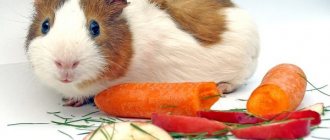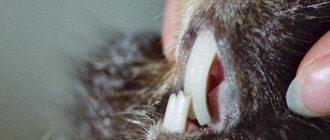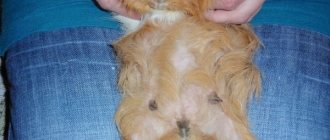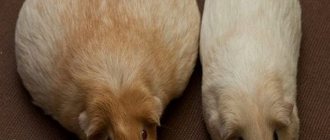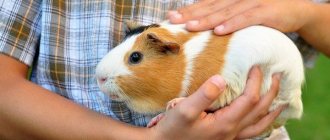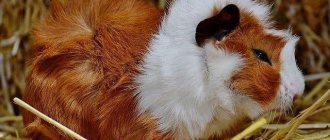Despite the guinea pig's strong immune system, it can also have health problems. Malfunction of the intestines occurs due to improper nutrition. If bowel movements begin to appear less frequently in the tray, you should be wary. Your guinea pig may be constipated and rarely poops. This may be a one-time occurrence or systematic. In any case, you can’t leave everything as it is. We need to find the cause and start treatment.
Symptoms
The animal will not be able to talk about its illness, nor will it be able to describe the nature of the pain. But his behavior will indicate a health problem. The first sign will be the pet's posture, which is characteristic of bowel movements, but it does not poop. Then apathy and refusal to eat appear, the pig withdraws from stroking the belly because it experiences pain in the intestines.
Important! First aid must be provided within 24 hours, otherwise the animal may experience rectal prolapse.
Significant symptoms of constipation:
- swollen and hard belly;
- lack of bowel movements or too dry and dense structure of feces;
- protrusion of the anus;
- dyspnea;
- possible increase in heart rate.
Examination of the animal
By taking a closer look at the animal, even without special education, you can identify symptoms of illness.
When examining the cage where the piglet is kept and the absence of fecal matter, it is necessary to remember whether there was any yesterday. Pigs are not coprophagous (eating their own feces), but when mineral balance is disturbed, sometimes such phenomena become the norm. And at the same time the animal will be playful and cheerful.
Examination of the animal and the conditions in which it is kept helps to identify the cause of constipation.
If your pig is truly constipated and you do not detect any fecal matter, then pay attention to:
- general condition (lethargy, depression, moaning, squeaking, grinding teeth);
- refusal of food (feeder with leftover food, the animal does not approach the feeder or has a perverted appetite);
- posture (hunched over, tucked or drooping tail, sitting dog pose, lying with tucked limbs);
- condition of the skin (dryness, dullness, roughness);
- condition of the abdominal part of the body (bloating, hardening, tympanic sound when tapping, pain when pressing on the walls).
Any of the signs should alert you and be a reason to contact a veterinarian.
Sometimes constipation alternates with diarrhea, or once constipation occurs, it turns into normal bowel movements, and after a while constipation occurs again.
Constipation often occurs at elevated temperatures. Water is absorbed very quickly from the intestines, and peristalsis cannot cope with fecal masses and evacuate them.
Causes of constipation
Despite the strong immunity of guinea pigs, due to poor quality food, an infection can enter the body. This and an unbalanced diet is the main cause of digestive problems.
Find out why guinea pig hair falls out.
Detailed analysis of nutritional errors:
- undereating or overeating;
- a lot of solid food at the expense of succulent foods;
- lack of vitamins;
- long interval between meals;
- lack of water;
- availability of food from a person’s table;
- low physical mobility.
The pet needs to be taken for a walk several times a day. A sedentary lifestyle leads not only to constipation, but also to obesity. Excess weight brings with it a whole bunch of diseases, problems with many vital organs and systems.
Features of sexual differences and a little about reproduction
When a new tenant appears in the house, of course it is interesting to find out who he is - a boy or a girl? This question should be of particular interest if you have several pigs. When examining the genitals of these babies, it can be difficult to understand their gender, since their organs are very similar to the eye. In males, the anal sac is more prominent. In females you can feel a fold at the bottom of the abdomen, in males there is a thin long vein. It is easier to determine gender by stool. In females the discharge is small and elongated, in males it looks like a rocker arm.
Pigs are born with open eyes and fur.
If you put pets of different sexes in the same cage, sooner or later expect a replenishment. Piglets are born with open eyes and fur, being completely independent. One mother can have up to six of them in her litter. If the plans did not include breeding animals, it is better to purchase one individual or two same-sex ones. Despite its nuances, caring for guinea pigs is not a complicated science. They can become good friends and brighten up your home time.
Treatment methods at home
A specialist in the treatment of guinea pigs is called a ratologist or rodentologist. His services are expensive, so many people prefer to treat constipation on their own at home. In principle, you won’t have to carry out complex procedures, but you need to know some nuances. Please note that your pet has a stomach ache and is feeling unwell; try to help correctly without causing even more pain. When you pick it up to give medicine, do it as carefully and accurately as possible.
Did you know? The ancestors of guinea pigs were the size of a giant bull and weighed more than 700 kg.
How to give an enema
If your pet stops going to the toilet, there are other symptoms of constipation. One of the most effective and fastest means of assistance is an enema. The drug Microlax is used, which begins to act within 5–15 minutes. The medicine stimulates the flow of water into the intestines to soften the bolus of feces .
After liquefaction, the product gently, without irritating the mucous membrane and without harming the walls of the rectum, removes stagnation. It is enough to administer 2 ml to a pig; a larger volume is not needed. The product is injected into the anus using a regular syringe without a needle, holding the animal with the other hand. Then you need to massage the stomach with your hand in the direction from the chest to the tail.
Using a laxative
Vaseline oil is used as a laxative to remove stagnant masses in animals. It envelops the intestines, softens and stimulates the natural urge to defecate. Using a syringe without a needle, a laxative is poured into the rodent’s mouth in the proportion of 2 ml/1 kg of weight, i.e. a young individual weighing 0.5 kg should be given 1 ml per dose.
We advise you to find out what guinea pigs like to play.
The drug is infused every 4 hours and stopped when there is a clear improvement . After each appointment, you need to do a light abdominal massage. To relieve pain, the pet is given 1-2 drops of the drug Metacam.
Nutrition for constipation
After the intestines are relieved, the pig's appetite will be restored, but it will need a special diet.
Allowed products during treatment:
- boiled beets and carrots;
- once a day 1–2 leaves of raw cabbage;
- raw zucchini, pumpkin, cucumber, sweet pepper;
- dried apples and rose hips;
- you can have greens - spinach, lettuce, dill;
- herbs - nettle, chamomile, dandelion, clover, alfalfa.
Fresh vegetables and herbs are provided in season; there is no need to buy imports in winter. Such peppers or cucumbers will not be good for future use. Give food 3–4 times a day, 1–1.5 tbsp. l. for the reception. To restore the microflora and speed up recovery, the rodent needs probiotics . One of the effective veterinary drugs is Pro-Colin. It restores the acid-base balance, microflora, inhibits pathogenic microorganisms and eliminates the symptoms of intestinal disorders. It is enough to give the pig 1 ml of paste-like product 2 times a day.
Important! It is strictly forbidden to give guinea pigs human food: sweets, baked goods, fried, sour, spicy.
Steps
Part 1
Set up a litter box
Observe your guinea pig and find out where it goes to the toilet most often.
The first step in toilet training a guinea pig is to observe your pet. In most cases, guinea pigs have a preferred location for the toilet. If you place the litter box in this exact location, you will increase the likelihood that your guinea pig will begin to use it for its intended purpose.
Monitor your guinea pig for a few days
Pay attention to where exactly your pet prefers to go to the toilet. The answer to this question can also be found out while cleaning the cage. Pay attention to where in the cage the most excrement and urine have accumulated.
- Place a litter box in the cage.
You can buy a toilet tray for a guinea pig, or you can make it yourself. Just make sure that it is comfortable for your pet to get in and out of it. Place the tray in the corner that your guinea pig most often uses as a toilet. - Make sure the litter box is large enough to accommodate your entire pet.
Make sure the sides of the tray are not very high. The guinea pig should have no difficulty getting over these walls.
If necessary, place several litter boxes in the cage.
Some guinea pigs like to go to the toilet in several corners of the cage at once. If you are faced with this exact situation, most likely your pet will not be able to use the only litter tray. When a guinea pig goes to the toilet not in one corner, but in several, it is necessary to place a litter tray in each such place.
Part 2
Encourage litter box use
See if your guinea pig will come to the litter box on its own accord.
For the most part, litter box training your guinea pig does not require any intervention. Some guinea pigs will start using the litter box right away and some will not. At the very beginning, you need to make sure that the guinea pig does not begin to climb into the tray on its own.
Many guinea pigs quickly understand the purpose of the litter box. If you are lucky, your pet will immediately begin to use it for its intended purpose.
Try stimulating your guinea pig to use the litter box with hay.
If your pet doesn't quite understand the purpose of the litter box, try putting some hay in the litter box. A guinea pig may climb into the tray when it sees hay in it. In addition, if the litter box smells of urine and feces, the pet will quickly realize that this is where it is necessary to go to the toilet.
Change the litter in the tray regularly.
Once your guinea pig starts using the litter box, change the litter regularly. Try to update it every three days. Know that your guinea pig will not go to the toilet in a dirty litter box.
Clean the litter box only every two weeks. In order for your guinea pig to continue using the litter box, there needs to be some odor left on it.
Constipation in a guinea pig occurs infrequently, since this animal has excellent immunity and, in principle, rarely gets sick. Problems with intestinal function in pigs usually occur due to improper feeding.
The main cause of intestinal dysfunction in guinea pigs, which is manifested by poor fecal output or its complete absence, is an incorrect diet, namely:
- excess solid dry food;
- constant overfeeding;
- long interval between feedings;
- lack of minerals;
- feeding your pet food intended for humans.
A lack of fluid in the body can also trigger stool retention, so it is important to ensure that your pet always has drinking water in his bowl. In addition, a common cause of constipation is inactivity of the animal.
This is usually observed in older pigs or when the pet is overweight.
If we talk about more serious causes of constipation in guinea pigs, these include:
- weakening of the intestinal muscles;
- diseases of the gastrointestinal tract;
- inflection of the gallbladder;
- gastrointestinal oncology;
- cysts, adhesions and other formations in the intestines.
If constipation in an animal caused by improper feeding can be eliminated independently, then the above factors require medical treatment.
Bloating and what to do
Flatulence or bloating occurs as a result of poor diet and precedes constipation. As mentioned above, the problem is provoked by several factors in the violation of the diet.
One of them is low-quality food, namely:
- wet fresh grass;
- hay treated with herbicides;
- stale, rotten hay or grain;
- lack of balance of vitamins in the feed.
In addition, you should not give your pig a lot of cabbage and root vegetables: these products provoke fermentation in the intestines. As a result, the accumulation of gases swells the abdomen, pressing on the walls of the digestive organs, causing pain. This condition is dangerous because, without an outlet, the accumulated gases can rupture the intestinal walls, which will lead to the death of the rodent. You can determine the problem by examining the abdomen - it increases in size up to 1.5 times.
In addition, there are other behavioral symptoms:
- The pet is apathetic, sitting with a ruffled face.
- It is difficult for him to breathe, and this can be seen by the heaving of his chest with each breath.
- He refuses to eat and drink.
As treatment, the pet is given the medicine “Espumizan” or “Bobotik” in a dosage of 0.3 ml 3-5 times a day, depending on the severity of the disease. It is advisable to massage his stomach and try to stir the rodent - active movements accelerate the release of gases. Afterwards you need to give the probiotic “Pro-Colin” (see above).
Did you know? The guinea pig was domesticated by the Incas 5 thousand years ago as a source of tasty meat.
To this day, some countries in South America serve dishes made from rodent meat.
Diseases caused by external factors
You can't escape bacteria. An animal, being surrounded by people or other pets, can become infected by airborne droplets, through poor-quality food or water, and infectious diseases. In such cases, the animal's health deteriorates and the animal refuses to eat. Elevated body temperature can lead to seizures. If we go into detail, the causes of diseases in guinea pigs are the same as in humans. Only the symptoms, treatment methods and diagnosis are different. Why is this happening? Because the pig lives with people and there are no serious deviations in the habitat of humans and the pig.
The only thing that can be recognized immediately is diseases caused by parasites. These include fleas, lice and ticks. Owners of long hair - guinea pigs, under the influence of parasites, lose part of their beautiful fur. With such diseases, abscesses may appear. To prevent this from happening, the owner must not only periodically comb the pig’s fur, but also clean the eyes, ears and claws. Fortunately, pet stores sell everything you need to care for pigs.
Diseases caused by parasites in the internal organs of an animal are almost incurable. Why? Because such a disease is recognized already too late. Flukes and tapeworms can live in the animal's intestines. And even if the pig could speak, it would hardly complain of being unwell. Such parasites are very insidious and act slowly. When a person eats low-quality food, loose stools or constipation, loss of appetite and apathy are common. Also acceptable for pigs. You cannot feed them food for other pets. Loving owners pamper their pig with “gourmet” food from the pet store, but problems still arise when the guinea pig does not eat or drink.
If the animal does not eat or drink, you should take your pet to the veterinarian
If suddenly the heating in the apartment is turned off in winter, and the animal’s comfort is forgotten, hypothermia occurs. It can lead to pneumonia and runny nose. These diseases are very dangerous for the animal, because its small body may not be able to withstand the fight against them. If the animal has an elevated body temperature or apathy, then be sure to take the pig to the doctor.
It is very important to devote time to the animal and not let it get bored for a long time. The psychological state of the pig also largely determines the strength of the immune system.
In addition, a joyful animal has a strong immune system and is less susceptible to apathy.
It is important to note that guinea pigs, like any other pets living in captivity, need a lot of vitamins. Without them, any living organism will not withstand the onslaught of harmful factors, and guinea pigs are no exception.
Variety is very important for a pig. Moreover, the animal cannot find food on its own. And the person has no idea what the pet actually needs.
When forming a pet’s diet, we must remember that it needs such “removable substances” as vitamins C, D, A, E. It is especially necessary to provide the animal with vitamin C, it will eliminate diseases such as scurvy. The animal's risk of contracting colds increases
Room lighting is very important for the animal, especially the presence of sunlight. Vitamin D contributes to the good condition of the animal's limbs
With its abundance, the risk of rickets in the animal is reduced. Vitamins A and E are the key to the beauty of a fluffy ball. Thanks to them, the animal’s fur remains beautiful and smooth. In addition, without these substances, the animal’s skin begins to peel off. Vitamin A is beneficial for the animal's visual organs.
Having a guinea pig at home is always a cause for joy. The children are delighted, mom can relax, dad calmly reads the newspaper in the evenings. But if the pig starts to get sick, it’s a disaster. There is no peace for anyone. The pet is sick! Such cases occur extremely rarely; usually, pigs are unpretentious and have strong immunity. But in cases of illness, be sure to take the pig to the veterinarian. The difficulty in defining a disease is that its signs are difficult to diagnose based on the animal’s behavior. Remember that a very dangerous condition is when a guinea pig does not eat or go to the toilet; you must contact a medical facility for a detailed diagnosis.
